The project is financed by the National Science Center and carried out at the Faculty „Artes Liberales” at the University of Warsaw in cooperation with the Dora Stratou Dance Theatre


| Testimony of: | knife |
| Source | Αβέρωφ 1989, 123 (in: EEH, sv. Μαχαίριν, p. 382-383) |
| Original text | Ο χορός του Μαχαιριού, του Δρεπανιού και της Τατσιάς λεγόταν ακόμη και Τσάμικος. Ο ένας από τους δύο χορευτές έχει τον κύριο ρόλο και ο άλλος εκτελεί χρέη βοηθού κρατώντας γερά ένα μαντήλι στον άλλον. Ο χορός είναι σε φόρμα τριμερή. Αρχίζει με μια γρήγορη κίνηση που παριστάνει τον χασάπη να παίρνει το μαχαίρι και να πηγαίνει στη δουλειά του κρατώντας το ψηλωμένο επιδεικτικά. Το μέτρο του ρυθμού αλλάζει από 2/4 σε 5/8. Μπήγει το μαχαίρι του στη γη. Το δρασκελά, πηδά από πάνω, κάνει τούμπες πάνω από αυτό με τη βοήθεια πάντοτε του συντρόφου του που του κρατά γερά το μαντήλι και στο τέλος κατορθώνει σε μια τούμπα να πάρει το μαχαίρι με τα δόντια του. Δεν επιτρέπεται ποτέ να το πάρει με το χέρι, διαφορετικά ο χορός θεωρείται αποτυχία και ο χορευτής γελοιοποιείται. Αφού λοιπόν σηκωθεί με το μαχαίρι στα δόντια, το παίρνει στο χέρι του και αρχίζει το κομμάτιασμα των κρεάτων. Σφάγιο στην περίπτωση αυτή είναι ο βοηθός. Ο χορευτής με το μαχαίρι του εκτελεί χαρακτηριστικές κινήσεις κομματιάσματος κρεάτων πάνω στον βοηθό, στο πρόσωπο, στο λαιμό, στο στήθος, στην κοιλιά, κάποτε γίνεται αρκετά τολμηρός, τόσο που οι θεατές βρίσκονται σε αγωνία μη τυχόν μια αδέξια κίνηση κτυπήσει τον άλλον. Αμα τελειώσει η φάση αυτή, που υποτίθεται ότι τέλειωσε τη δουλειά του, χαρούμενος και ικανοποιημένος γυρίζει στο σπίτι του. Την ικανοποίηση και χαρά του εκφράζει το τρίτο μέρος της μουσικής με τον ελαφρό γοργό ρυθμό και την μικρή παραλλαγή από το πρώτο μέρος με τα διπλά δοξάρια στις νότες. Σαν χορός του μαχαιριού συνηθιζόταν πολύ στους γάμους και ήταν μια μεγάλη επίδειξη των νέων προς τις συγκεντρωμένες και καλοστολισμένες κοπέλλες του χωριού καθισμένες ολόγυρα να τους παρακολουθούν. Καταγραφή της μελωδίας σε ευρωπαϊκή σημειογραφία. |
| English translation | Also, Tsamikos was considered to be the dance of the Knife, the Sickle and the Tray. One of the two dancers had the leading role, and the other was a helper, holding the other firmly by the kerchief. The dance has a tri-partite form - it starts with a quick move, which represents the butcher who takes a knife and goes to his work, holding it high ostentatiously. The rhythm meter is changing from 2/4 to 5/8. He thrusts the knife in the earth. He strides around it, jumps and makes somersaults over it - always helped by his partner who firmly holds the kerchief - and by the end, picks up the knife with his teeth. It is never allowed to pick it up with the hand - otherwise the dance is considered a failure, and the dancer is mocked. After he picks the knife up with his teeth, he takes it in his hand and starts to chop the meat. In this scenario the assistant plays the role of the carcass. The dancer makes characteristic motions with the knife, mimicking the cutting and portioning of the helper: the face, the neck, the chest, the abdomen; sometimes he becomes too daring so the spectators are anxious over whether he might kill his helper with one wrong move. But this phase comes to an end and it is assumed he finished his job - he can return home, happy and content. The content is expressed by the third part of the music, with a quick light rhythm and small variation from the first part with double bows in notes. As a dance of the knife it was often danced at weddings, and it was a showing off of young men before the gathered, well-dressed girls of the village, who were sitting around and watching the dance. The recording of the melody [attached], in European notation. |
| Time/occasion of occurence | harvest |
| Region of occurence | Cyprus - Show on map |
| Function | confirming manliness/dexterity, |
| Dance name | Makhairia |